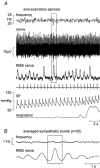Resting discharge of human muscle spindles is not modulated by increases in sympathetic drive
- PMID: 12923218
- PMCID: PMC2343296
- DOI: 10.1113/jphysiol.2003.040196
Resting discharge of human muscle spindles is not modulated by increases in sympathetic drive
Abstract
There is evidence in experimental animals that, in addition to receiving fusimotor drive, muscle spindles are subject to modulation by the sympathetic nervous system. We examined the validity of this idea in human subjects by recording from muscle spindles in the relaxed ankle and toe extensor muscles during a strong and sustained physiological activation of muscle sympathetic outflow. Unitary recordings were made from 20 primary and 17 secondary muscle spindle afferents via a tungsten microelectrode inserted percutaneously into the peroneal nerve in 10 awake, healthy subjects seated with the legs supported in the extended position. ECG, blood pressure, respiration and calf circumference were also recorded. The majority of the muscle spindles were spontaneously active at rest; a background discharge was induced in four silent spindles by vibrating the tendon. A sustained increase in muscle vasoconstrictor activity, an increase in calf volume and a fall in pulse pressure were produced by subjects performing a 30-40 s maximal inspiratory breath-hold. Despite this strong increase in muscle sympathetic outflow no significant changes occurred in the discharge of either primary or secondary muscle spindle afferents, measured as a change in mean frequency and variability over sequential 5 s epochs and compared with the preceding period of rest. Strong chemoreceptor-driven sympathetic bursts during sustained expiratory breath-holds also failed to modulate the firing of 14 spindle endings. We conclude that a sustained, physiological increase in muscle sympathetic activity causes no detectable change in muscle spindle firing, lending no support to the concept that the sympathetic nervous system can influence the sensitivity of human muscle spindles directly.
Figures




Similar articles
-
Sympathetic outflow enhances the stretch reflex response in the relaxed soleus muscle in humans.J Appl Physiol (1985). 2005 Apr;98(4):1366-70. doi: 10.1152/japplphysiol.00955.2004. Epub 2004 Nov 12. J Appl Physiol (1985). 2005. PMID: 15542572 Clinical Trial.
-
The vestibular system does not modulate fusimotor drive to muscle spindles in relaxed leg muscles of subjects in a near-vertical position.J Neurophysiol. 2016 May 1;115(5):2529-35. doi: 10.1152/jn.01125.2015. Epub 2016 Mar 2. J Neurophysiol. 2016. PMID: 26936989 Free PMC article.
-
Differential activation of sympathetic discharge to skin and skeletal muscle in humans.Acta Physiol Scand Suppl. 1997;639:1-32. Acta Physiol Scand Suppl. 1997. PMID: 9421582 Review.
-
The vestibular system does not modulate fusimotor drive to muscle spindles in contracting leg muscles of seated subjects.Exp Brain Res. 2013 Jun;227(2):175-83. doi: 10.1007/s00221-013-3497-1. Epub 2013 Apr 4. Exp Brain Res. 2013. PMID: 23552997
-
Recording and quantifying sympathetic outflow to muscle and skin in humans: methods, caveats and challenges.Clin Auton Res. 2021 Feb;31(1):59-75. doi: 10.1007/s10286-020-00700-6. Epub 2020 Jun 25. Clin Auton Res. 2021. PMID: 32588247 Free PMC article. Review.
Cited by
-
Sympathetic innervation of human muscle spindles.J Anat. 2015 Jun;226(6):542-8. doi: 10.1111/joa.12309. J Anat. 2015. PMID: 25994126 Free PMC article.
-
Modulation of human muscle spindle discharge by arterial pulsations--functional effects and consequences.PLoS One. 2012;7(4):e35091. doi: 10.1371/journal.pone.0035091. Epub 2012 Apr 17. PLoS One. 2012. PMID: 22529975 Free PMC article.
-
Influence of sympathetic nervous system on sensorimotor function: whiplash associated disorders (WAD) as a model.Eur J Appl Physiol. 2006 Nov;98(5):423-49. doi: 10.1007/s00421-006-0312-8. Epub 2006 Oct 12. Eur J Appl Physiol. 2006. PMID: 17036216 Review.
-
Emotions alter muscle proprioceptive coding of movements in humans.Sci Rep. 2017 Aug 16;7(1):8465. doi: 10.1038/s41598-017-08721-4. Sci Rep. 2017. PMID: 28814736 Free PMC article.
-
Enhancing motor performance through brief skin cooling: exploring the role of enhanced sympathetic tone and muscle spindle sensitivity.Eur J Appl Physiol. 2025 Feb;125(2):443-453. doi: 10.1007/s00421-024-05597-x. Epub 2024 Sep 22. Eur J Appl Physiol. 2025. PMID: 39307853
References
-
- Edin BB, Vallbo ÅB. Dynamic response of human muscle spindle afferents to stretch. J Neurophysiol. 1990a;63:1297–1306. - PubMed
-
- Edin BB, Vallbo ÅB. Muscle afferent responses to isometric contractions and relaxations in humans. J Neurophysiol. 1990b;63:1307–1313. - PubMed
-
- Elam M, McKenzie D, Macefield V. Mechanisms of sympatho-excitation: single-unit analysis of muscle vasoconstrictor neurons in awake OSAS subjects. J Appl Physiol. 2002;93:297–303. - PubMed
-
- Gandevia SC, Burke D. Effect of training on voluntary activation of human fusimotor neurons. J Neurophysiol. 1985;54:1422–1429. - PubMed
Publication types
MeSH terms
LinkOut - more resources
Full Text Sources

